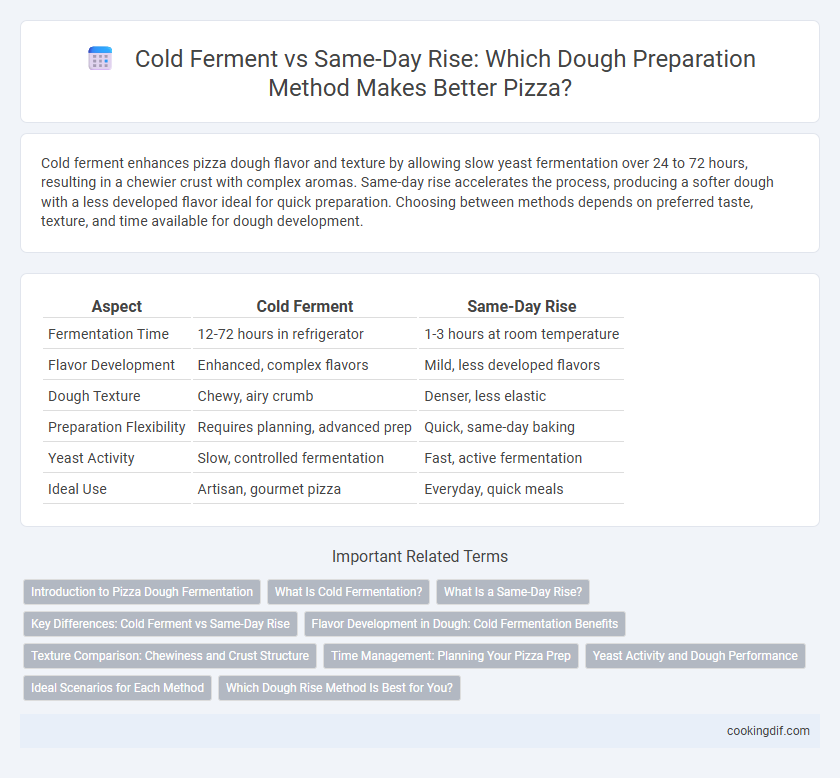Cold ferment enhances pizza dough flavor and texture by allowing slow yeast fermentation over 24 to 72 hours, resulting in a chewier crust with complex aromas. Same-day rise accelerates the process, producing a softer dough with a less developed flavor ideal for quick preparation. Choosing between methods depends on preferred taste, texture, and time available for dough development.
Table of Comparison
| Aspect | Cold Ferment | Same-Day Rise |
|---|---|---|
| Fermentation Time | 12-72 hours in refrigerator | 1-3 hours at room temperature |
| Flavor Development | Enhanced, complex flavors | Mild, less developed flavors |
| Dough Texture | Chewy, airy crumb | Denser, less elastic |
| Preparation Flexibility | Requires planning, advanced prep | Quick, same-day baking |
| Yeast Activity | Slow, controlled fermentation | Fast, active fermentation |
| Ideal Use | Artisan, gourmet pizza | Everyday, quick meals |
Introduction to Pizza Dough Fermentation
Cold ferment pizza dough undergoes a slow fermentation process in the refrigerator, typically lasting 24 to 72 hours, which enhances flavor complexity and improves dough texture by allowing enzymes to break down starches and proteins. Same-day rise involves a quicker fermentation at room temperature, usually completed within 1 to 4 hours, resulting in a softer, less developed flavor and a more tender crust. Choosing between cold ferment and same-day rise depends on the desired flavor profile, texture, and available preparation time for pizza dough.
What Is Cold Fermentation?
Cold fermentation is a dough preparation process where pizza dough is allowed to rise slowly in a refrigerated environment, typically between 24 to 72 hours. This extended fermentation enhances gluten development and flavor complexity by allowing yeast to produce organic acids and alcohols over time. The result is a dough with improved texture, chewiness, and a distinctive tangy taste compared to same-day rise dough.
What Is a Same-Day Rise?
A same-day rise in pizza dough preparation involves mixing the dough and allowing it to ferment and rise for a few hours at room temperature before shaping and baking. This method produces a faster fermentation process, giving the dough a lighter texture but less developed flavor compared to cold fermentation. Same-day rise dough is ideal for quick pizza making while still achieving a soft, airy crust.
Key Differences: Cold Ferment vs Same-Day Rise
Cold ferment dough undergoes a slow fermentation process in the refrigerator for 24 to 72 hours, enhancing flavor complexity and dough structure due to extended yeast activity and enzyme reactions. Same-day rise dough is prepared and baked within a few hours, resulting in a quicker turnaround but less developed taste and texture. Key differences include fermentation time, flavor depth, dough extensibility, and scheduling flexibility for pizza preparation.
Flavor Development in Dough: Cold Fermentation Benefits
Cold fermentation enhances dough flavor by allowing yeast and enzymes to slowly break down starches and proteins over 24 to 72 hours, resulting in complex, tangy notes and improved crust texture. This process increases organic acid production, which contributes to a more pronounced aromatic profile compared to same-day rise methods. Cold-fermented dough also retains moisture better, producing a chewier, more flavorful pizza base that elevates the overall taste experience.
Texture Comparison: Chewiness and Crust Structure
Cold ferment dough develops a chewier texture due to extended enzymatic activity breaking down starches and proteins, creating a more complex gluten network. Same-day rise produces a lighter, airier crust with less chewiness, as the gluten has less time to strengthen and develop structure. The cold-fermented crust typically has a crispier, more developed outer layer, while same-day dough results in a softer, more tender bite.
Time Management: Planning Your Pizza Prep
Cold ferment extends dough fermentation over 24 to 72 hours at low temperatures, enhancing flavor complexity and texture while requiring advanced planning. Same-day rise accelerates fermentation within 2 to 4 hours at room temperature, ideal for quick pizza preparation but may yield less developed flavors. Effective time management balances flavor development and preparation speed, allowing optimal dough quality based on schedule constraints.
Yeast Activity and Dough Performance
Cold ferment dough undergoes a slow yeast activation process at low temperatures, enhancing enzyme activity that develops complex flavors and improves gluten structure. Same-day rise relies on faster yeast fermentation at room temperature, producing quicker gas expansion but less depth in taste and chewiness. Cold ferment typically results in a dough with superior extensibility and crispiness, while same-day rise dough is more prone to overproofing and less consistent texture.
Ideal Scenarios for Each Method
Cold ferment is ideal for artisan-style pizzas, enhancing flavor complexity through slow yeast activity over 24 to 72 hours in refrigerated conditions. Same-day rise suits quick, high-volume pizza production, allowing dough to be prepared and baked within 2 to 4 hours while maintaining a lighter, less tangy crust. Each method optimizes texture and taste based on desired dough development time and operational demands.
Which Dough Rise Method Is Best for You?
Cold ferment dough undergoes a slow rise in the refrigerator for 24 to 72 hours, resulting in enhanced flavor complexity and improved texture due to extended yeast activity. Same-day rise dough typically takes 3 to 6 hours at room temperature, offering a quicker preparation but with less developed taste and a softer crust. Choosing between these methods depends on your desired flavor intensity, time availability, and the preferred chewiness or crispness of your pizza crust.
Cold ferment vs same-day rise for dough preparation Infographic

 cookingdif.com
cookingdif.com